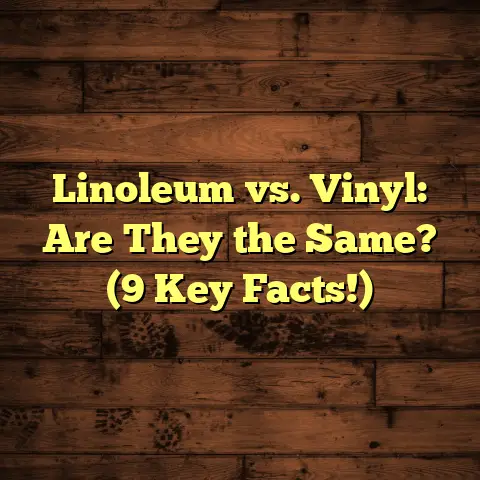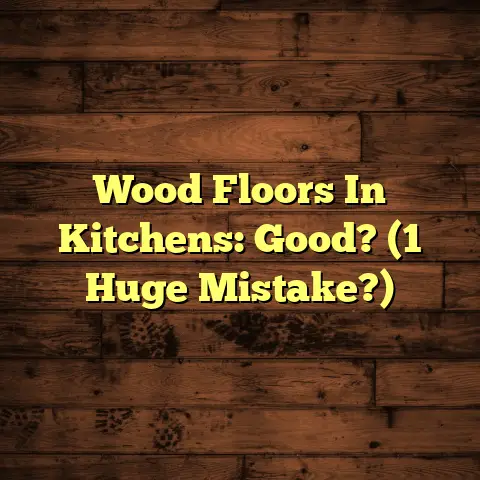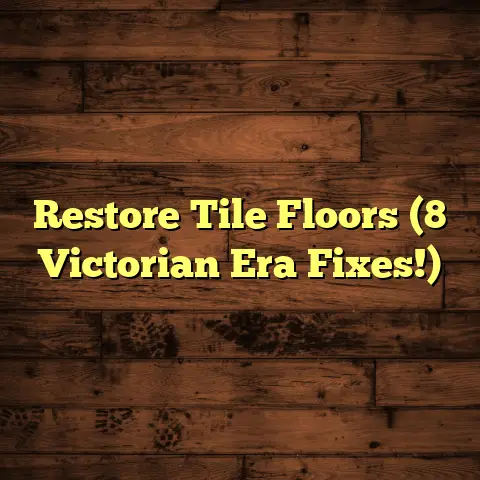Best Garage Floor Coating? (3 Top Pro Secrets!)
One thing I’ve learned is that a good garage floor coating is absolutely crucial. It’s not just about looks, it’s about protection and longevity.
Think about it: your garage floor endures heavy traffic, dropped tools, oil spills, and harsh chemicals. Without a solid coating, it’s a recipe for disaster.
A durable garage floor coating can withstand all of that, resisting stains and protecting against those nasty chemicals. Plus, it instantly elevates the look of your garage!
In this article, I’m going to let you in on three pro secrets that will help you choose the best garage floor coating. These aren’t just tips; they are game-changers I’ve learned over years of hands-on experience.
I’ll walk you through everything, from understanding the different types of coatings to the nitty-gritty of application. So, let’s dive in!
Section 1: Understanding Garage Floor Coatings
So, what exactly is a garage floor coating? It’s essentially a protective layer applied over your concrete floor to enhance its durability and appearance.
Think of it as armor for your garage floor. There are several types available, each with its own strengths and weaknesses. Let’s break them down:
-
Epoxy: This is probably the most well-known type. Epoxy coatings are durable, resistant to chemicals, and offer a glossy finish. They’re a great all-around choice.
-
Polyurethane: Polyurethane coatings are more flexible than epoxy, making them better at withstanding impacts and abrasions. They’re also UV resistant, so they won’t yellow over time.
-
Polyaspartic: This is the new kid on the block, and it’s quickly gaining popularity. Polyaspartic coatings are incredibly durable, fast-curing, and resistant to a wide range of chemicals and temperatures.
-
Acrylic: Acrylic coatings are water-based and easy to apply, but they’re not as durable as epoxy or polyurethane. They’re a good option for light-duty garages.
-
Garage Floor Paint: While technically not a coating, it’s often mistaken as one. Paint is the least durable option, offering minimal protection against chemicals and wear.
Each type has different properties. Epoxy is known for its hardness, polyurethane for its flexibility, and polyaspartic for its rapid curing time. Here’s a simple table to illustrate:
| Coating Type | Durability | Flexibility | Chemical Resistance | Cure Time | Cost |
|---|---|---|---|---|---|
| Epoxy | High | Medium | High | Medium | Moderate |
| Polyurethane | High | High | High | Medium | Moderate |
| Polyaspartic | Very High | Medium | Very High | Fast | High |
| Acrylic | Low | Medium | Low | Slow | Low |
| Garage Paint | Very Low | Low | Very Low | Slow | Very Low |
But how do you choose the right one? Well, several factors come into play.
Climate is a big one. If you live in an area with extreme temperature fluctuations, you’ll want a coating that can handle it without cracking or peeling.
Usage is another key consideration. Is your garage just for parking cars, or do you use it as a workshop? If it’s a workshop, you’ll need a more durable coating to withstand heavy tools and potential spills.
And don’t forget about the existing condition of your floor. Are there cracks or damage? These need to be addressed before applying any coating.
For example, I worked on a garage in Minnesota where the temperature swings were extreme. We opted for a polyaspartic coating because of its superior temperature resistance.
On the other hand, I had a client in California who primarily used their garage for parking. An epoxy coating worked perfectly for their needs.
Section 2: The Importance of Durability in Garage Floor Coatings
Let’s be real: durability isn’t just a nice-to-have, it’s a must-have for garage floor coatings. Why? Because your garage floor takes a beating!
Think about the weight of your vehicles, the constant foot traffic, the dropped tools, and the potential for chemical spills. A durable coating is the only thing standing between your floor and total destruction.
I’ve seen firsthand what happens when people skimp on durability. The coating cracks, peels, and stains, leaving the floor looking worse than before. And trust me, repairing or replacing a damaged floor is way more expensive than investing in a durable coating in the first place.
But it’s not just about avoiding damage. A durable coating also enhances safety. A smooth, non-porous surface is easier to clean and less likely to harbor bacteria or mold. Plus, it can provide better traction, reducing the risk of slips and falls.
According to a study by the National Safety Council, falls are a leading cause of injury in the home. A durable, slip-resistant garage floor coating can help prevent these accidents.
Consider a garage used as a workshop. It’s a high-traffic area with potential for dropped tools, spills, and heavy equipment. A durable epoxy or polyaspartic coating would be ideal in this scenario.
On the other hand, a garage used primarily for parking might get away with a less expensive acrylic coating, although I still recommend epoxy or polyaspartic for long-term value.
I remember one client who had a beautiful classic car collection. He wanted a garage floor that would not only protect the floor but also complement the cars. We went with a high-gloss epoxy coating, and he was thrilled with the results.
But durability isn’t just about protecting the floor; it’s also about protecting your investment. A durable coating will last longer, saving you money in the long run.
Think of it this way: you can either spend a little more upfront on a durable coating or spend a lot more later on repairs and replacements. It’s a no-brainer, right?
Section 3: Top Pro Secret #1 – Proper Surface Preparation
Alright, let’s get to the first pro secret: meticulous surface preparation. I can’t stress this enough: proper surface preparation is the foundation of a long-lasting garage floor coating.
Think of it like painting a wall. You wouldn’t just slap paint on a dirty, uneven surface, would you? The same principle applies to garage floors.
Before applying any coating, you need to thoroughly clean, repair, and etch the surface. Here’s a step-by-step guide:
-
Cleaning: Start by removing all items from the garage. Then, sweep or vacuum the floor to remove any loose debris. Next, use a degreaser to remove any oil or grease stains. Rinse thoroughly with water and let the floor dry completely.
-
Repairing Cracks: Use a concrete crack filler to repair any cracks or damage. Follow the manufacturer’s instructions for application and drying time.
-
Etching: This is a crucial step that many DIYers skip. Etching opens up the pores of the concrete, allowing the coating to adhere properly. You can use a concrete etching solution or muriatic acid. Be sure to follow safety precautions when working with these chemicals.
-
Rinsing and Drying: After etching, rinse the floor thoroughly with water and let it dry completely. This may take several hours or even overnight.
For etching, I prefer using a concrete etching solution because it’s safer and easier to use than muriatic acid. But if you choose to use muriatic acid, be sure to wear protective gear, including gloves, goggles, and a respirator.
I’ve seen countless projects fail because of inadequate surface preparation. The coating peels, bubbles, and cracks, resulting in a huge waste of time and money.
One time, I was called in to fix a garage floor that had been coated by another contractor. The coating was peeling up in large chunks. After inspecting the floor, it was clear that the surface hadn’t been properly etched.
We had to remove the entire coating, re-etch the surface, and apply a new coating. It was a costly and time-consuming process that could have been avoided with proper preparation.
Here are some expert tips for effective surface preparation:
- Use a concrete grinder to smooth out any uneven surfaces.
- Use a shop vac to remove any dust or debris after grinding or etching.
- Test the porosity of the concrete by pouring a small amount of water on the surface. If the water beads up, the concrete is not porous enough and needs to be etched further.
Don’t rush this step. Take your time and do it right. It will make all the difference in the long run.
Section 4: Top Pro Secret #2 – Choosing the Right Product
Now that you know the importance of surface preparation, let’s talk about choosing the right product. This is where things can get a little overwhelming, but don’t worry, I’m here to guide you.
As I mentioned earlier, there are several types of garage floor coatings available, each with its own unique properties and ideal applications.
Epoxy is a great all-around choice. It’s durable, chemical-resistant, and offers a glossy finish. However, it can be brittle and prone to cracking in extreme temperatures.
Polyurethane is more flexible than epoxy, making it better at withstanding impacts and abrasions. It’s also UV resistant, so it won’t yellow over time.
Polyaspartic is the top-of-the-line option. It’s incredibly durable, fast-curing, and resistant to a wide range of chemicals and temperatures. However, it’s also the most expensive option.
Acrylic is a budget-friendly option, but it’s not as durable as epoxy or polyurethane. It’s best suited for light-duty garages.
When choosing a product, it’s important to read the label carefully. Look for information on durability ratings, cure times, and chemical resistance.
The durability rating indicates how well the coating can withstand wear and tear. Look for a coating with a high abrasion resistance rating.
The cure time is the amount of time it takes for the coating to fully harden. Fast-curing coatings are ideal for busy garages, while slower-curing coatings may offer better durability.
Chemical resistance is important if you plan to use your garage for working on cars or other projects that involve chemicals. Look for a coating that is resistant to oil, gasoline, solvents, and other common chemicals.
Here are some popular brands and products that are trusted by professionals in the industry:
- Rust-Oleum EpoxyShield: A popular and affordable epoxy coating.
- Valspar Premium Clear Epoxy Coating Kit: A high-quality epoxy coating with excellent durability.
- ArmorPoxy: A wide range of epoxy and polyaspartic coatings for various applications.
I always recommend consulting with a professional before choosing a product. They can assess your specific needs and recommend the best coating for your garage.
I remember one client who was determined to use a cheap acrylic coating on his garage floor. I tried to explain to him that it wouldn’t hold up to the heavy use he planned for the garage, but he wouldn’t listen.
A few months later, he called me back complaining that the coating was peeling and cracking. He had to pay me to remove the acrylic coating and apply a more durable epoxy coating.
Moral of the story: don’t skimp on quality. Choose the right product for your needs, and you’ll be much happier in the long run.
Section 5: Top Pro Secret #3 – Application Techniques
Okay, you’ve prepped the surface and chosen the right product. Now it’s time to apply the coating. This is where your attention to detail will really pay off.
The key to a successful application is to follow the manufacturer’s instructions carefully. These instructions are there for a reason, and deviating from them can lead to problems.
Before you start, make sure you have all the necessary tools and materials. This includes:
- Mixing buckets: For mixing the coating components.
- Mixing sticks: For stirring the coating.
- Rollers: For applying the coating to the floor.
- Brushes: For cutting in edges and corners.
- Spiked shoes: For walking on the wet coating without leaving footprints.
- Respirator: To protect yourself from fumes.
- Gloves: To protect your hands.
When mixing the coating, be sure to follow the manufacturer’s instructions precisely. Use the correct ratio of components and mix thoroughly.
Apply the coating in thin, even coats. Avoid applying too much coating at once, as this can lead to bubbles and uneven drying.
Use a roller to apply the coating to the main areas of the floor, and use a brush to cut in edges and corners.
Work in small sections and overlap each section slightly to ensure even coverage.
After applying the first coat, let it dry completely before applying the second coat. This will typically take 24-48 hours, depending on the product and the temperature.
Here are some common pitfalls to avoid during the application process:
- Applying the coating in direct sunlight: This can cause the coating to dry too quickly and unevenly.
- Applying the coating in humid conditions: This can cause the coating to bubble and peel.
- Walking on the wet coating without spiked shoes: This will leave footprints and ruin the finish.
- Rushing the application process: Take your time and pay attention to detail.
I remember one time I was working on a garage floor in the middle of summer. It was a hot, humid day, and I was rushing to get the job done.
I didn’t realize that the humidity was causing the coating to bubble until it was too late. The entire floor was covered in tiny bubbles.
I had to remove the entire coating and start over. It was a costly mistake that could have been avoided if I had paid more attention to the weather conditions.
The key to a successful application is patience and attention to detail. Take your time, follow the instructions, and avoid common pitfalls.
Conclusion
So, there you have it: the three top pro secrets to choosing the best garage floor coating.
First, proper surface preparation is crucial for a long-lasting finish. Don’t skip this step!
Second, choose the right product for your specific needs and conditions. Consider durability, chemical resistance, and cure time.
Third, master application techniques for optimal results. Follow the manufacturer’s instructions carefully and avoid common pitfalls.
Remember, a durable garage floor coating is an investment that will protect your floor, enhance safety, and save you money in the long run.
By following these pro secrets, you can achieve a garage floor that looks great and lasts for years to come.
Now it’s time to take action. Consider your specific garage needs and apply the secrets discussed in this article to make an informed decision about your garage floor coating.
Good luck, and happy coating!





